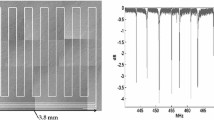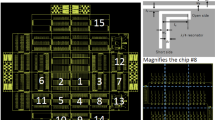Abstract
Kinetic inductance detectors (KIDs) have become an attractive alternative to traditional bolometers in the sub-mm and mm observing community due to their innate frequency multiplexing capabilities and simple lithographic processes. These advantages make KIDs a viable option for the O(500,000) detectors needed for the upcoming Cosmic Microwave Background-Stage 4 experiment. We have fabricated an antenna-coupled MKID array in the 150 GHz band optimized for CMB detection. Our design uses a twin-slot antenna coupled to an inverted microstrip made from a superconducting Nb/Al bilayer as the strip, a Nb ground plane and a SiN\(_x\) dielectric layer in between, which is then coupled to an Al KID grown on high-resistivity Si. We present the fabrication process and measurements of SiN\(_x\) microstrip resonators.





Similar content being viewed by others
Notes
Heidelberg MLA150: https://himt.de/index.php/maskless-write-lasers.html.
PlasmaTherm ICP Fluorine Etcher: http://www.plasma-therm.com/apex_SLR.html.
YES CV200 RFS Plasma Strip/Descum System: http://www.yieldengineering.com/products/plasma-strip-descum-systems/cv200rf-series.
PlasmaTherm VERSALINE HDPCVD: http://www.plasma-therm.com/versaline.html.
PlasmaTherm VERSALINE DSE: http://www.plasma-therm.com/versaline-dse.html.
References
Planck Collaboration, Astron. Astrophys. 594, A13 (2016). https://doi.org/10.1051/0004-6361/201525830
CMB-S4 Collaboration, arXiv:1610.02743 [astro-ph.CO] J. Baselmans, J. Low Temp. Phys. 167, 292 (2011). https://doi.org/10.1007/s10909-011-0448-8
C.M. Posada et al., Supercond. Sci. Technol. 28(9), 094002 (2015). https://doi.org/10.1088/0953-2048/28/9/094002
J. van der Kuur et al., IEEE Trans. Appl. Supercond. 25, 3 (2015). https://doi.org/10.1109/TASC.2015.2393716
E. Shirokoff et al., Proc. SPIE 8452, 84520R (2012). https://doi.org/10.1117/12.927070
M. Calvo, A. Benot, A. Catalano et al., J. Low Temp. Phys. 184, 816 (2016). https://doi.org/10.1007/s10909-016-1582-0
L.J. Swenson et al., Proc. SPIE 8452, 84520P (2012). https://doi.org/10.1117/12.926223
H. McCarrick et al., Proc. SPIE 9914, 99140O (2016). https://doi.org/10.1117/12.2231830
B.R. Johnson et al., Proc. SPIE 9914, 99140X (2016). https://doi.org/10.1117/12.2233243
P.S. Barry et al., J. Low Temp. Phys. (2018). https://doi.org/10.1007/s10909-018-1943-y
A. Hornsby et al., J. Low Temp. Phys. (2018, submitted)
E.E. Quealy, The POLARBEAR Cosmic Microwave Background Polarization Experiment and Anti-reflection Coatings for Millimeter Wave Observations (University of California, Berkeley, 2012)
D.F. Filipovic, S.S. Gearhartm, G.M. Rebeiz, I.E.E.E. Trans, Microw. Theory Tech. 41(10), 1738 (1993). https://doi.org/10.1109/22.247919
K. Geerlings, S. Shankar, E. Edwards, L. Frunzio, R.J. Schoelkopf, M.H. Devoret, Appl. Phys. Lett. 100, 192601 (2012). https://doi.org/10.1063/1.4710520
R. Basu Thakur, Q.Y. Tang, E. Shirokoff, F. Carter, R. McGeehan, IEEE Trans. Appl. Supercond. 27, 4 (2017). https://doi.org/10.1109/TASC.2016
Acknowledgements
This work is partially supported by NSF Award #1554565 and the Kavli NSF-PFC3 Detector Development Grant. This work was supported in part by the Kavli Institute for Cosmological Physics at the University of Chicago through Grant NSF PHY-1125897 and an endowment from the Kavli Foundation and its founder Fred Kavli. This work made use of the Pritzker Nanofabrication Facility of the Institute for Molecular Engineering at the University of Chicago, which receives support from SHyNE, a node of the National Science Foundations National Nanotechnology Coordinated Infrastructure (NSF NNCI-1542205).
Author information
Authors and Affiliations
Corresponding author
Rights and permissions
About this article
Cite this article
Tang, Q.Y., Barry, P.S., Basu Thakur, R. et al. Fabrication of Antenna-Coupled KID Array for Cosmic Microwave Background Detection. J Low Temp Phys 193, 149–156 (2018). https://doi.org/10.1007/s10909-018-1941-0
Received:
Accepted:
Published:
Issue Date:
DOI: https://doi.org/10.1007/s10909-018-1941-0




